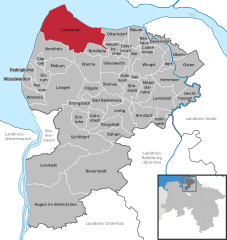Cuxhaven
| Cuxhaven | ||
|---|---|---|
 | ||
| ||
 Cuxhaven | ||
Location of Cuxhaven within Cuxhaven district 
 | ||
| Coordinates: 53°51′40″N 08°41′40″E / 53.86111°N 8.69444°ECoordinates: 53°51′40″N 08°41′40″E / 53.86111°N 8.69444°E | ||
| Country | Germany | |
| State | Lower Saxony | |
| District | Cuxhaven | |
| Government | ||
| • Mayor | Ulrich Getsch (independent) | |
| Area | ||
| • Total | 161.91 km2 (62.51 sq mi) | |
| Elevation | 2 m (7 ft) | |
| Population (2012-12-31)[1] | ||
| • Total | 48,829 | |
| • Density | 300/km2 (780/sq mi) | |
| Time zone | CET/CEST (UTC+1/+2) | |
| Postal codes | 27472, 27474, 27476, 27478 | |
| Dialling codes | 04721-04724 | |
| Vehicle registration | CUX | |
| Website | www.cuxhaven.de | |
Cuxhaven (German pronunciation: [kʊksˈhaːfən]) is an independent town and seat of the Cuxhaven district, in Lower Saxony, Germany. It is situated on the shore of the North Sea at the mouth of the Elbe River. Cuxhaven has a footprint of 14 kilometres (9 miles) (east-west) by 7 km (4 mi) (north-south). Its town quarters Duhnen, Döse and Sahlenburg are especially popular vacation spots on the North Sea and home to about 52,000 residents.
Cuxhaven is home to an important fisherman's wharf and ship registration point for Hamburg as well as the Kiel Canal until 2008. Tourism is also of great importance. The city and its precursor Ritzebüttel belonged to Hamburg from the 13th century until 1937. The island of Neuwerk, a Hamburg dependency, is located just northwest of Cuxhaven in the North Sea. The city's symbol, known as the Kugelbake is a beacon once used as a lighthouse; the wooden landmark on the mouth of the Elbe marks the boundary between the river and the North Sea and also adorns the city's coat of arms.
History

Ritzebüttel, today a part of Cuxhaven, belonged to the Land of Hadeln, first an exclave of the younger Duchy of Saxony and after its de facto dynastic partition in 1296 of the Duchy of Saxe-Lauenburg, established de jure in 1260. In 1394 the city of Hamburg conquered the fortress of Ritzebüttel and made it its stronghold to protect the estuary of the river Elbe, which connects that city with the open sea. On March 15, 1907 Cuxhaven gained city status within the state of Hamburg. In 1937 Cuxhaven became an urban district of the Stade Region within the Prussian Province of Hanover by the Greater Hamburg Act. In 1972 some municipalities of the neighboured rural district of Land of Hadeln were incorporated into the urban district of Cuxhaven. In 1977 Cuxhaven lost the status as urban district and was integrated into the new rural District of Cuxhaven, being its capital.
During the First World War Nordholz Airbase with its airship hangars, near Nordholz to the south of Cuxhaven, was one of the major German naval airship stations.
Between 1945 and 1964 various experiments in rocketry were performed near Cuxhaven.
Tourism

_by-RaBoe.jpg)
The origins of tourism go back to the year 1816 when a seaside resort was founded in Cuxhaven. Since 1964 Cuxhaven has been a state-recognized climate seaside resort (Seeheilbad) and centre of the so-called holiday region of Cuxland.
Other information

A few kilometers off the Cuxhaven coast lies the island of Neuwerk. At low tide the water recedes so far from the coast that the island can be reached either by mudflat hiking or by horse carriage.
A modern landmark of Cuxhaven is the Friedrich-Clemens-Gerke Tower, a telecommunication tower built of concrete, which is not accessible to the public. It is not really a landmark, for all the cities in Germany have a similar tower.
The High test peroxide (HTP) Submarine U 1407, was raised from where she had been scuttled in Cuxhaven after WWII and rebuilt by the British, being commissioned as HMS Meteorite. It was the catalyst for a series of German-made Air-independent propulsion submarines such as the Type 212 submarine and Type 214 submarine.
Twin towns
Notable Residents
- Carsten Niebuhr, mathematician, cartographer, and explorer of the Arabian Peninsula under the service of Denmark
- Joachim Ringelnatz, poet, cabaret artiste and painter. Since 2002 the city hosts the Joachim Ringelnatz-Museum, managed by the Roachim Ringelnatz-Foundation.
- Finn-Ole Heinrich (de), author and film-maker was born in Cuxhaven.
See also
References
External links
| Wikimedia Commons has media related to Cuxhaven. |
- Official site (German)
- Operation "Backfire" and rocket experiments at Cuxhaven (German)
- Panoramic views from Cuxhaven
- Further Tourist Information
 |
Neuwerk, Heligoland, North Sea | North Sea |  | |
| North Sea | |
Elbe river | ||
| ||||
| | ||||
| Wilhelmshaven | Bremerhaven, Bremen | Stade, Hamburg |
